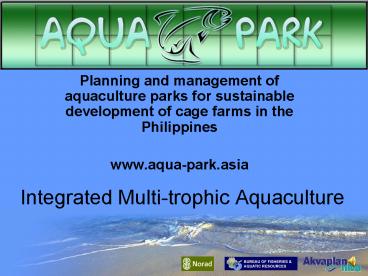Integrated Multi-trophic Aquaculture - PowerPoint PPT Presentation
1 / 17
Title:
Integrated Multi-trophic Aquaculture
Description:
Planning and management of aquaculture parks for sustainable development of cage farms in the Philippines www.aqua-park.asia Integrated Multi-trophic Aquaculture – PowerPoint PPT presentation
Number of Views:457
Avg rating:3.0/5.0
Title: Integrated Multi-trophic Aquaculture
1
Integrated Multi-trophic Aquaculture
- Planning and management of aquaculture parks for
sustainable development of cage farms in the
Philippines - www.aqua-park.asia
2
Theory
- Fed species
- 70 of feed nutrients are release to the
environment - Nutrients gt Algae gt Plankton gt Fish
- Extractive species can capture some of these
excess nutrients - Nutrients extracted directly by algae
- Algae and zooplankton by molluscs (oysters, pearl
oysters) - Zooplankton by fish
3
Nutrient cycle
4
Concept for IMTA
5
Integrated Multi-trophic Aquaculture
- Developing Integrated Multitrophic Aquaculture
practice into Mariculture Parks
6
IMTA
- Fish
- Molluscs
- Seaweed
7
Wastes from cages reaching suspended culture
of waste feed and faeces intersecting suspended
culture
20 17 12 7
7 15 22 25
Suspended culture
Sediment
25 m 10 m 5 m 3m 0 m 0 m
3m 5m 10 m 25m
Distance from cage edge (m)
Further away from the cages (25 m), particles
have settled out and do not reach the suspended
culture
8
Wastes from cages reaching suspended culture at
different depths
of waste feed and faeces intersecting suspended
culture
0-3m 3-6m 6-9m 9-12m 12-15m
1 4 11 16
13 9 5 1
2 5 8 8
7 6 6 2
2 2 3 2
2 2 2 2
1 1 1 1
1 1 2 2
1 1 1 1
1 1 1 1
25 m 10 m 5 m 3m 0 m 0 m
3m 5m 10 m 25m
Distance from cage edge (m)
The majority of the wastes intersect the
suspended culture in the top 6 m these wastes
are mostly fine and slow settling Milkfish
faeces Net depth is important when considering
optimum depth of suspended culture
9
North
7 12 17 20
Percentage of waste feed and faeces reaching
suspended culture
4 10 16 20
13 9 5 1
25 22 15 7
For Panabo, residual current to the south means
predictions are higher at the IMTA units to the
south, and lower to the east
Distance from cages 3m 5m 10m
25m
10
Nutrient plume from cages reaching seaweed
culture at different depths
of plume intersecting seaweed culture to the
EAST of the cages
19 14 8 3
0-3m 3-6m 6-9m 9-12m 12-15m
2 2 lt1 lt1
lt1 lt1 lt1 lt1
lt1 lt1 lt1 lt1
lt1 lt1 lt1 lt1
0m 3m 5m 10m 25m
Distance from cage edge (m)
The majority of the plume containing dissolved
nutrients intersects the seaweed culture in the
top 3 m. Net depth is important when
considering optimum depth of seaweed culture
11
Nutrient plume from cages reaching seaweed
culture at different depths
of plume intersecting seaweed culture to the
SOUTH of the cages
Plan view
0-3m 3-6m 6-9m 9-12m 12-15m
N
9 18 26 32
2 3 3 3
lt1 lt1 lt1 lt1
lt1 lt1lt1 lt1
lt1 lt1 lt1 lt1
25 m 10 m 5 m 3m 0 m
Distance from cage edge (m)
More of the plume intersects seaweed culture to
the south of the cages as this is the direction
of the residual current Net depth is important
when considering optimum depth of seaweed culture
12
Nutrient plume from a large polar circle cage
reaching seaweed culture at different depths
of plume intersecting seaweed culture to the
SOUTH of the cages
0-3m 3-6m 6-9m 9-12m 12-15m
Plan view
N
6 10 11 12
6 10 12 12
5 7 9 10
1 1 2 1
lt1 lt1 lt1 lt1
25 m 10 m 5 m 3m 0 m
Distance from cage edge (m)
A deeper net means more of the suspended line
comes into contact with the plume Seaweed
culture at depth will be limited by light rather
than nutrients
13
Nutrient uptake by benthic structures TROPOMOD
predictions of the waste feed and faeces
depositing on 8 m by 8 m structures on the sea
bed
Structures for benthic culture
14
North
Nutrient uptake by Benthic structures
lt1 1 3
Percentage of waste feed and faeces reaching
bethic structures
4
2 lt1 lt1
0 lt1 4
For structures on the sea bed, around 20 of
wastes deposited within 8 m of the cages Fine,
slow settling Milkfish faeces are dispersed away
from these structures
4 lt1 lt1
Distance from cages 3m 11m 19m
15
Concept of cage within a cage
16
Cage in a cage Grouper are in the inner cage,
Milkfish in the outer cage Clean outer nets are
essential Assumptions all units are dry mass
except the ration
100 units wet feed
3 feed
11 faeces
1 feed
7 faeces
1 faeces
Grouper wasted feed 12, digestibility 49 ,
wet FCR 7.5 Milkfish consumes 70 of waste
feed, 30 of waste faeces
17
Cage in a cage
- Cage in a cage illustration

